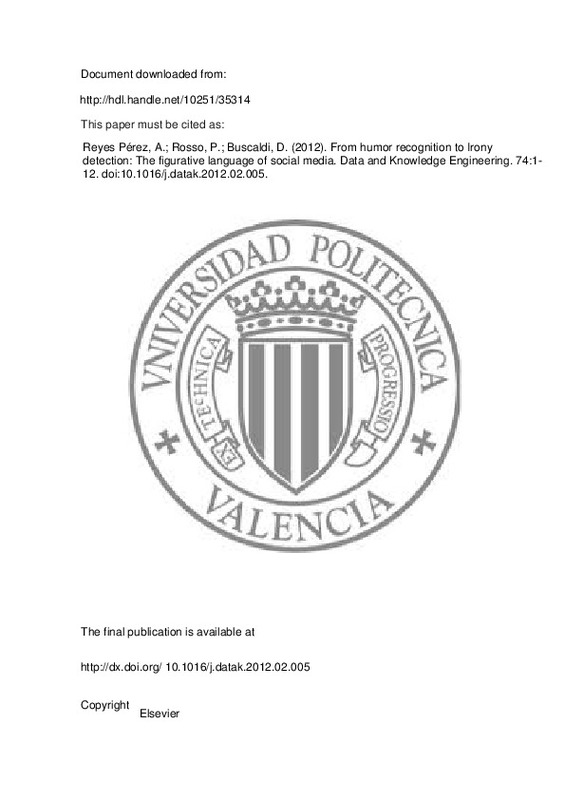JavaScript is disabled for your browser. Some features of this site may not work without it.
Buscar en RiuNet
Listar
Mi cuenta
Estadísticas
Ayuda RiuNet
Admin. UPV
From humor recognition to Irony detection: The figurative language of social media
Mostrar el registro sencillo del ítem
Ficheros en el ítem
| dc.contributor.author | Reyes Pérez, Antonio
|
es_ES |
| dc.contributor.author | Rosso, Paolo
|
es_ES |
| dc.contributor.author | Buscaldi, Davide
|
es_ES |
| dc.date.accessioned | 2014-02-03T09:12:56Z | |
| dc.date.issued | 2012-04 | |
| dc.identifier.issn | 0169-023X | |
| dc.identifier.uri | http://hdl.handle.net/10251/35314 | |
| dc.description.abstract | [EN] The research described in this paper is focused on analyzing two playful domains of language: humor and irony, in order to identify key values components for their automatic processing. In particular, we are focused on describing a model for recognizing these phenomena in social media, such as "tweets". Our experiments are centered on five data sets retrieved from Twitter taking advantage of user-generated tags, such as "#humor" and "#irony". The model, which is based on textual features, is assessed on two dimensions: representativeness and relevance. The results, apart from providing some valuable insights into the creative and figurative usages of language, are positive regarding humor, and encouraging regarding irony. (C) 2012 Elsevier B.V. All rights reserved. | es_ES |
| dc.description.sponsorship | This work has been done in the framework of the VLC/CAMPUS Microcluster on Multimodal Interaction in Intelligent Systems and it has been partially funded by the European Commission as part of the WIQEI IRSES project (grant no. 269180) within the FP 7 Marie Curie People Framework, and by MICINN as part of the Text-Enterprise 2.0 project (TIN2009-13391-C04-03) within the Plan I + D + I. The National Council for Science and Technology (CONACyT - Mexico) has funded the research work of Antonio Reyes. | en_EN |
| dc.format.extent | 12 | es_ES |
| dc.language | Inglés | es_ES |
| dc.publisher | Elsevier | es_ES |
| dc.relation.ispartof | Data and Knowledge Engineering | es_ES |
| dc.rights | Reserva de todos los derechos | es_ES |
| dc.subject | Humor recognition | es_ES |
| dc.subject | Irony detection | es_ES |
| dc.subject | Natural language processing | es_ES |
| dc.subject | Web text analysis | es_ES |
| dc.subject.classification | LENGUAJES Y SISTEMAS INFORMATICOS | es_ES |
| dc.title | From humor recognition to Irony detection: The figurative language of social media | es_ES |
| dc.type | Artículo | es_ES |
| dc.embargo.lift | 10000-01-01 | |
| dc.embargo.terms | forever | es_ES |
| dc.identifier.doi | 10.1016/j.datak.2012.02.005 | |
| dc.relation.projectID | info:eu-repo/grantAgreement/MICINN//TIN2009-13391-C04-03/ES/Text-Enterprise 2.0: Tecnicas De Comprension De Textos Aplicadas A Las Necesidades De La Empresa 2.0/ | es_ES |
| dc.relation.projectID | info:eu-repo/grantAgreement/EC/FP7/269180/EU/Web Information Quality Evaluation Initiative/ | |
| dc.rights.accessRights | Abierto | es_ES |
| dc.contributor.affiliation | Universitat Politècnica de València. Departamento de Sistemas Informáticos y Computación - Departament de Sistemes Informàtics i Computació | es_ES |
| dc.description.bibliographicCitation | Reyes Pérez, A.; Rosso, P.; Buscaldi, D. (2012). From humor recognition to Irony detection: The figurative language of social media. Data and Knowledge Engineering. 74:1-12. https://doi.org/10.1016/j.datak.2012.02.005 | es_ES |
| dc.description.accrualMethod | S | es_ES |
| dc.relation.publisherversion | http://dx.doi.org/ 10.1016/j.datak.2012.02.005 | es_ES |
| dc.description.upvformatpinicio | 1 | es_ES |
| dc.description.upvformatpfin | 12 | es_ES |
| dc.type.version | info:eu-repo/semantics/publishedVersion | es_ES |
| dc.description.volume | 74 | es_ES |
| dc.relation.senia | 232472 | |
| dc.contributor.funder | European Commission | |
| dc.contributor.funder | Ministerio de Ciencia e Innovación | |
| dc.contributor.funder | Consejo Nacional de Ciencia y Tecnología, México |







![[Cerrado]](/themes/UPV/images/candado.png)

